Setting Characteristics and High Compressive Strength of an Anti-washout, Injectable Calcium Phosphate Cement Combined with Thermosensitive Hydrogel
Abstract
1. Introduction
2. Materials and Methods
2.1. Materials and Preparation
2.2. Characterization
2.2.1. Setting Time
2.2.2. Injectability
2.2.3. Anti-washout Property
2.2.4. Viscosity Test
2.2.5. Compressive Strength Test
2.2.6. Porosity
2.2.7. In Vitro Degradation
2.2.8. Structural and Chemical Analysis
2.2.9. Statistical Analysis
3. Result
3.1. Setting Time
3.2. Injectability
3.3. Antiwashout Property
3.4. Viscosity
3.5. Compressive Strength
3.6. Porosity
3.7. In Vitro Degradation
3.7.1. Weight Loss
3.7.2. pH Value
3.8. Phase Composition Analysis
3.9. FTIR Spectra
3.10. XPS Spectra
3.11. Microstructure
4. Discussion
5. Conclusions
Author Contributions
Funding
Conflicts of Interest
References
- Shi, H.; Zhang, W.; Liu, X.; Zeng, S.; Yu, T.; Zhou, C. Synergistic effects of citric acid—Sodium alginate on physicochemical properties of α-tricalcium phosphate bone cement. Ceram. Int. 2019, 45, 2146–2152. [Google Scholar] [CrossRef]
- Sahin, E.; Kalyon, D.M. The rheological behavior of a fast-setting calcium phosphate bone cement and its dependence on deformation conditions. J. Mech. Behav. Biomed. Mater. 2017, 72, 252–260. [Google Scholar] [CrossRef]
- Paknahad, A.; Kucko, N.W.; Leeuwenburgh, S.C.G.; Sluys, L.J. Experimental and numerical analysis on bending and tensile failure behavior of calcium phosphate cements. J. Mech. Behav. Biomed. Mater. 2020, 103. [Google Scholar] [CrossRef]
- Castro, A.G.B.; Polini, A.; Azami, Z.; Leeuwenburgh, S.C.G.; Jansen, J.A.; Yang, F.; van den Beucken, J.J.J.P. Incorporation of PLLA micro-fillers for mechanical reinforcement of calcium-phosphate cement. J. Mech. Behav. Biomed. Mater. 2017, 71, 286–294. [Google Scholar] [CrossRef]
- Shu, Y.; Zhou, Y.; Ma, P.; Li, C.; Ge, C.; Wang, Y.; Li, Q.; Yu, K.; Lu, R.; Zou, X.; et al. Degradation in vitro and in vivo of beta-TCP/MCPM-based premixed calcium phosphate cement. J. Mech. Behav. Biomed. Mater. 2019, 90, 86–95. [Google Scholar] [CrossRef]
- Bruckner, T.; Meininger, M.; Groll, J.; Kubler, A.C.; Gbureck, U. Magnesium Phosphate Cement as Mineral Bone Adhesive. Materials 2019, 12, 3819. [Google Scholar] [CrossRef]
- No, Y.J.; Holzmeister, I.; Lu, Z.F.; Prajapati, S.; Shi, J.; Gbureck, U.; Zreiqat, H. Effect of Baghdadite Substitution on the Physicochemical Properties of Brushite Cements. Materials 2019, 12, 1719. [Google Scholar] [CrossRef]
- Torres, P.M.; Gouveia, S.; Olhero, S.; Kaushal, A.; Ferreira, J.M. Injectability of calcium phosphate pastes: Effects of particle size and state of aggregation of beta-tricalcium phosphate powders. Acta Biomater. 2015, 21, 204–216. [Google Scholar] [CrossRef]
- Liu, C.S.; Shao, H.F.; Chen, F.Y.; Zheng, H.Y. Rheological properties of concentrated aqueous injectable calcium phosphate cement slurry. Biomaterials 2006, 27, 5003–5013. [Google Scholar] [CrossRef]
- Li, X.M.; He, F.P.; Ye, J.D. Preparation, characterization and in vitro cell performance of anti-washout calcium phosphate cement modified by sodium polyacrylate. RSC Adv. 2017, 7, 32842–32849. [Google Scholar] [CrossRef]
- Nezafati, N.; Farokhi, M.; Heydari, M.; Hesaraki, S.; Nasab, N.A. In vitro bioactivity and cytocompatablity of an injectable calcium phosphate cement/silanated gelatin microsphere composite bone cement. Compos. B Eng. 2019, 175. [Google Scholar] [CrossRef]
- Qian, G.; Li, X.; He, F.; Ye, J. Improvement of anti-washout property of calcium phosphate cement by addition of konjac glucomannan and guar gum. J. Mater. Sci. Mater. Med. 2018, 29, 183. [Google Scholar] [CrossRef]
- Liu, J.Q.; Li, J.Y.; Ye, J.D. Properties and Cytocompatibility of Anti-Washout Calcium Phosphate Cement by Introducing Locust Bean Gum. J. Mater. Sci. Technol. 2016, 32, 1021–1026. [Google Scholar] [CrossRef]
- Shi, H.; Ye, X.; Zhang, J.; Ye, J. Enhanced Osteogenesis of Injectable Calcium Phosphate Bone Cement Mediated by Loading Chondroitin Sulfate. ACS Biomater. Sci. Eng. 2018, 5, 262–271. [Google Scholar] [CrossRef]
- Liu, H.; Zhang, Z.; Gao, C.; Bai, Y.; Liu, B.; Wang, W.; Ma, Y.; Saijilafu; Yang, H.; Li, Y.; et al. Enhancing effects of radiopaque agent BaSO4 on mechanical and biocompatibility properties of injectable calcium phosphate composite cement. Mater. Sci. Eng. C 2020, 116, 110904. [Google Scholar] [CrossRef]
- Wang, S.; Xu, C.; Yu, S.C.; Wu, X.P.; Jie, Z.; Dai, H.L. Citric acid enhances the physical properties, cytocompatibility and osteogenesis of magnesium calcium phosphate cement. J. Mech. Behav. Biomed. Mater. 2019, 94, 42–50. [Google Scholar] [CrossRef]
- Hettich, G.; Schierjott, R.A.; Epple, M.; Gbureck, U.; Heinemann, S.; Mozaffari-Jovein, H.; Grupp, T.M. Calcium Phosphate Bone Graft Substitutes with High Mechanical Load Capacity and High Degree of Interconnecting Porosity. Materials 2019, 12, 3471. [Google Scholar] [CrossRef]
- Weichhold, J.; Gbureck, U.; Goetz-Neunhoeffer, F.; Hurle, K. Setting Mechanism of a CDHA Forming alpha-TCP Cement Modified with Sodium Phytate for Improved Injectability. Materials 2019, 12, 2098. [Google Scholar] [CrossRef]
- Maazouz, Y.; Montufar, E.B.; Malbert, J.; Espanol, M.; Ginebra, M.P. Self-hardening and thermoresponsive alpha tricalcium phosphate/pluronic pastes. Acta Biomater. 2017, 49, 563–574. [Google Scholar] [CrossRef]
- Sun, J.G.; Liu, X.; Lei, Y.; Tang, M.Y.; Dai, Z.X.; Yang, X.W.; Yu, X.B.; Yu, L.; Sun, X.H.; Ding, J.D. Sustained subconjunctival delivery of cyclosporine A using thermogelling polymers for glaucoma filtration surgery. J. Mat. Chem. B 2017, 5, 6400–6411. [Google Scholar] [CrossRef]
- Osorno, L.L.; Maldonado, D.E.; Whitener, R.J.; Brandley, A.N.; Yiantsos, A.; Medina, J.D.R.; Byrne, M.E. Amphiphilic PLGA-PEG-PLGA triblock copolymer nanogels varying in gelation temperature and modulus for the extended and controlled release of hyaluronic acid. J. Appl. Polym. Sci. 2020, 137. [Google Scholar] [CrossRef]
- Lai, M.C.; Chang, K.C.; Hsu, S.C.; Chou, M.C.; Hung, W.I.; Hsiao, Y.R.; Lee, H.M.; Hsieh, M.F.; Yeh, J.M. In situ gelation of PEG-PLGA-PEG hydrogels containing high loading of hydroxyapatite: In vitro and in vivo characteristics. Biomed. Mater. 2014, 9, 015011. [Google Scholar] [CrossRef]
- Peng, K.T.; Chen, C.F.; Chu, I.M.; Li, Y.M.; Hsu, W.H.; Hsu, R.W.; Chang, P.J. Treatment of osteomyelitis with teicoplanin-encapsulated biodegradable thermosensitive hydrogel nanoparticles. Biomaterials 2010, 31, 5227–5236. [Google Scholar] [CrossRef]
- Yu, L.; Xu, W.; Shen, W.J.; Cao, L.P.; Liu, Y.; Li, Z.S.; Ding, J.D. Poly(lactic acid-co-glycolic acid)-poly(ethylene glycol)-poly(lactic acid-co-glycolic acid) thermogel as a novel submucosal cushion for endoscopic submucosal dissection. Acta Biomater. 2014, 10, 1251–1258. [Google Scholar] [CrossRef]
- Ding, Z.W.; Li, H.; Wei, J.; Li, R.J.; Yan, Y.G. Developing a novel magnesium glycerophosphate/silicate-based organic-inorganic composite cement for bone repair. Mater. Sci. Eng. C Mater. Biol. Appl. 2018, 87, 104–111. [Google Scholar] [CrossRef]
- Liu, W.Z.; Zhang, J.T.; Weiss, P.; Tancret, F.; Bouler, J.M. The influence of different cellulose ethers on both the handling and mechanical properties of calcium phosphate cements for bone substitution. Acta Biomater. 2013, 9, 5740–5750. [Google Scholar] [CrossRef]
- Wu, I.T.; Kao, P.F.; Huang, Y.R.; Ding, S.J. In vitro and in vivo osteogenesis of gelatin-modified calcium silicate cement with washout resistance. Mater. Sci. Eng. C Mater. Biol. Appl. 2020, 117. [Google Scholar] [CrossRef]
- Habraken, W.J.; Liao, H.B.; Zhang, Z.; Wolke, J.G.; Grijpma, D.W.; Mikos, A.G.; Feijen, J.; Jansen, J.A. In vivo degradation of calcium phosphate cement incorporated into biodegradable microspheres. Acta Biomater. 2010, 6, 2200–2211. [Google Scholar] [CrossRef]
- Zhang, J.; Liu, W.; Schnitzler, V.; Tancret, F.; Bouler, J.M. Calcium phosphate cements for bone substitution: Chemistry, handling and mechanical properties. Acta Biomater. 2014, 10, 1035–1049. [Google Scholar] [CrossRef]
- Kamali, H.; Khodaverdi, E.; Hadizadeh, F. Ring-opening polymerization of PLGA-PEG-PLGA triblock copolymer in supercritical carbon dioxide. J. Supercrit. Fluids 2018, 137, 9–15. [Google Scholar] [CrossRef]
- Smith, B.T.; Lu, A.; Watson, E.; Santoro, M.; Melchiorri, A.J.; Grosfeld, E.C.; van den Beucken, J.; Jansen, J.A.; Scott, D.W.; Fisher, J.P.; et al. Incorporation of fast dissolving glucose porogens and poly(lactic-co-glycolic acid) microparticles within calcium phosphate cements for bone tissue regeneration. Acta Biomater. 2018, 78, 341–350. [Google Scholar] [CrossRef]
- Sugawara, A.; Asaoka, K.; Ding, S.J. Calcium phosphate-based cements: Clinical needs and recent progress. J. Mat. Chem. B 2013, 1, 1081–1089. [Google Scholar] [CrossRef]
- Lodoso-Torrecilla, I.; Stumpel, F.; Jansen, J.A.; van den Beucken, J. Early-stage macroporosity enhancement in calcium phosphate cements by inclusion of poly(N-vinylpyrrolidone) particles as a porogen. Mater. Today Commun. 2020, 23, 8. [Google Scholar] [CrossRef]
- Smith, B.T.; Santoro, M.; Grosfeld, E.C.; Shah, S.R.; van den Beucken, J.J.J.P.; Jansen, J.A.; Mikos, A.G. Incorporation of fast dissolving glucose porogens into an injectable calcium phosphate cement for bone tissue engineering. Acta Biomater. 2017, 50, 68–77. [Google Scholar] [CrossRef]
- Dorozhkin, S.V. Calcium orthophosphate cements for biomedical application. J. Mater. Sci 2008, 43, 3028–3057. [Google Scholar] [CrossRef]
- Yu, T.; Gao, C.Y.; Ye, J.D.; Zhang, M. Synthesis and Characterization of a Novel Silver-Substituted Calcium Phosphate Cement. J. Mater. Sci. Technol. 2014, 30, 686–691. [Google Scholar] [CrossRef]
- Richter, R.F.; Ahlfeld, T.; Gelinsky, M.; Lode, A. Development and Characterization of Composites Consisting of Calcium Phosphate Cements and Mesoporous Bioactive Glass for Extrusion-Based Fabrication. Materials 2019, 12, 2022. [Google Scholar] [CrossRef]
- Yao, Z.Q.; Ivanisenko, Y.; Diemant, T.; Caron, A.; Chuvilin, A.; Jiang, J.Z.; Valiev, R.Z.; Qi, M.; Fecht, H.J. Synthesis and properties of hydroxyapatite-containing porous titania coating on ultrafine-grained titanium by micro-arc oxidation. Acta Biomater. 2010, 6, 2816–2825. [Google Scholar] [CrossRef]
- Chen, X.B.; Li, Y.C.; Hodgson, P.D.; Wen, C. Microstructures and bond strengths of the calcium phosphate coatings formed on titanium from different simulated body fluids. Mat. Sci. Eng. C Bio. S 2009, 29, 165–171. [Google Scholar] [CrossRef]
- Koh, I.; Lopez, A.; Pinar, A.B.; Helgason, B.; Ferguson, S.J. The effect of water on the mechanical properties of soluble and insoluble ceramic cements. J. Mech. Behav. Biomed. Mater. 2015, 51, 50–60. [Google Scholar] [CrossRef]
- Liu, W.; Zhang, J.; Rethore, G.; Khairoun, K.; Pilet, P.; Tancret, F.; Bouler, J.M.; Weiss, P. A novel injectable, cohesive and toughened Si-HPMC (silanized-hydroxypropyl methylcellulose) composite calcium phosphate cement for bone substitution. Acta Biomater. 2014, 10, 3335–3345. [Google Scholar] [CrossRef]
- Nie, L.; Chen, D.; Fu, J.; Yang, S.H.; Hou, R.X.; Suo, J.P. Macroporous biphasic calcium phosphate scaffolds reinforced by poly-L-lactic acid/hydroxyapatite nanocomposite coatings for bone regeneration. Biochem. Eng. J. 2015, 98, 29–37. [Google Scholar] [CrossRef]
- Chaudhry, A.A.; Knowles, J.C.; Rehman, I.; Darr, J.A. Rapid hydrothermal flow synthesis and characterisation of carbonate- and silicate-substituted calcium phosphates. J. Biomater. Appl. 2013, 28, 448–461. [Google Scholar] [CrossRef]
- Spence, G.; Patel, N.; Brooks, R.; Bonfield, W.; Rushton, N. Osteoclastogenesis on hydroxyapatite ceramics: The effect of carbonate substitution. J. Biomed. Mater. Res. A 2010, 92A, 1292–1300. [Google Scholar] [CrossRef]
- Lanao, R.P.F.; Leeuwenburgh, S.C.G.; Wolke, J.G.C.; Jansen, J.A. In vitro degradation rate of apatitic calcium phosphate cement with incorporated PLGA microspheres. Acta Biomater. 2011, 7, 3459–3468. [Google Scholar] [CrossRef]



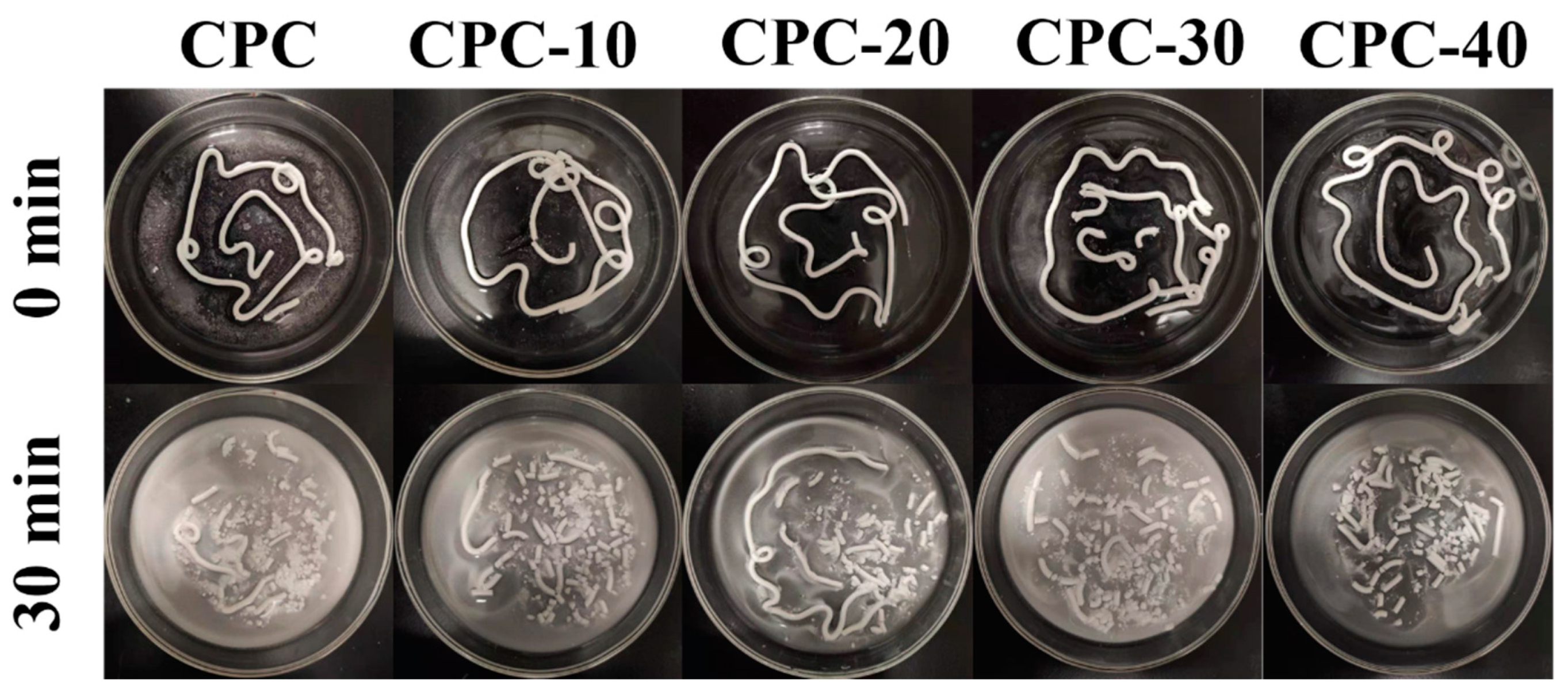
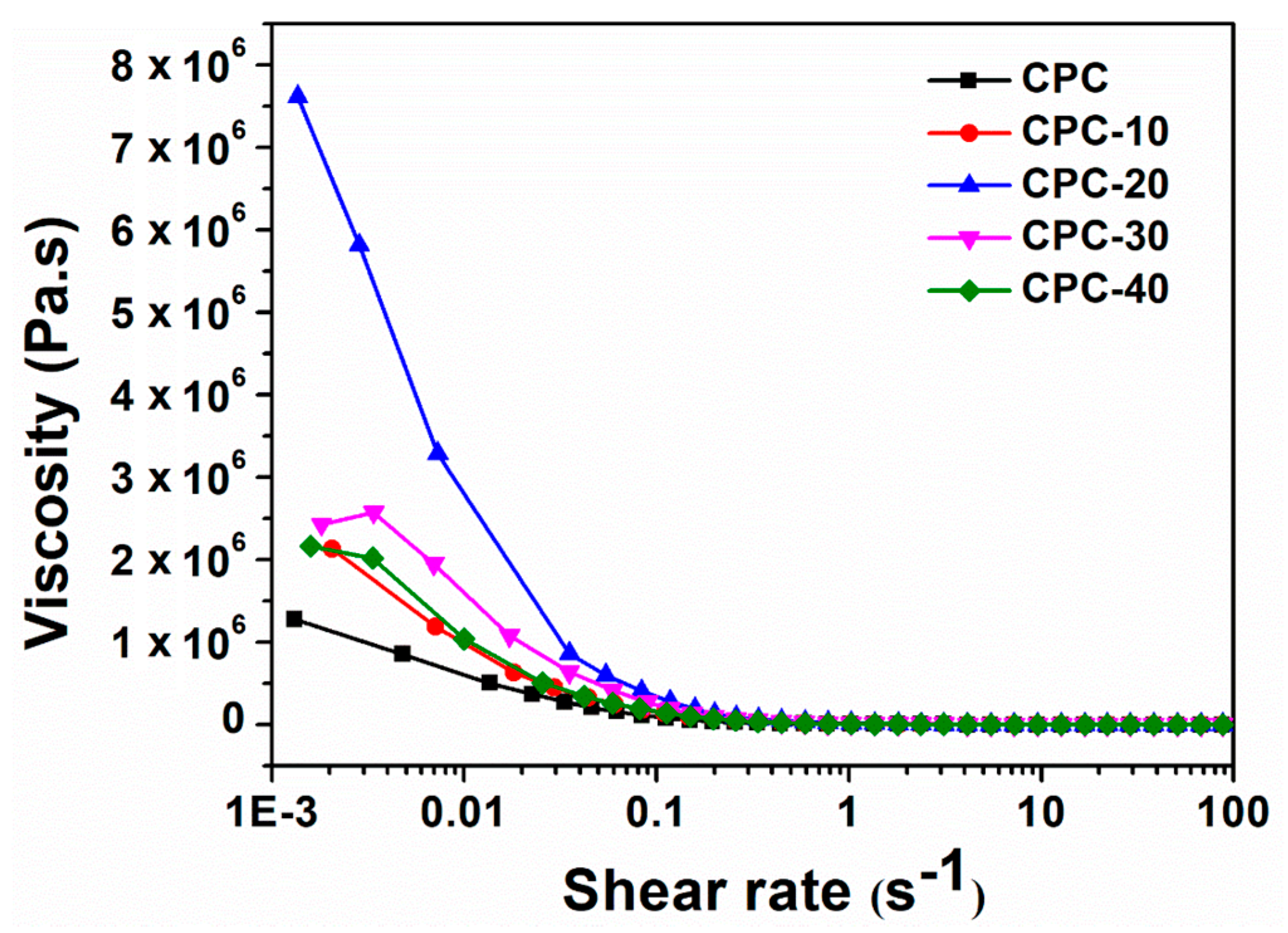
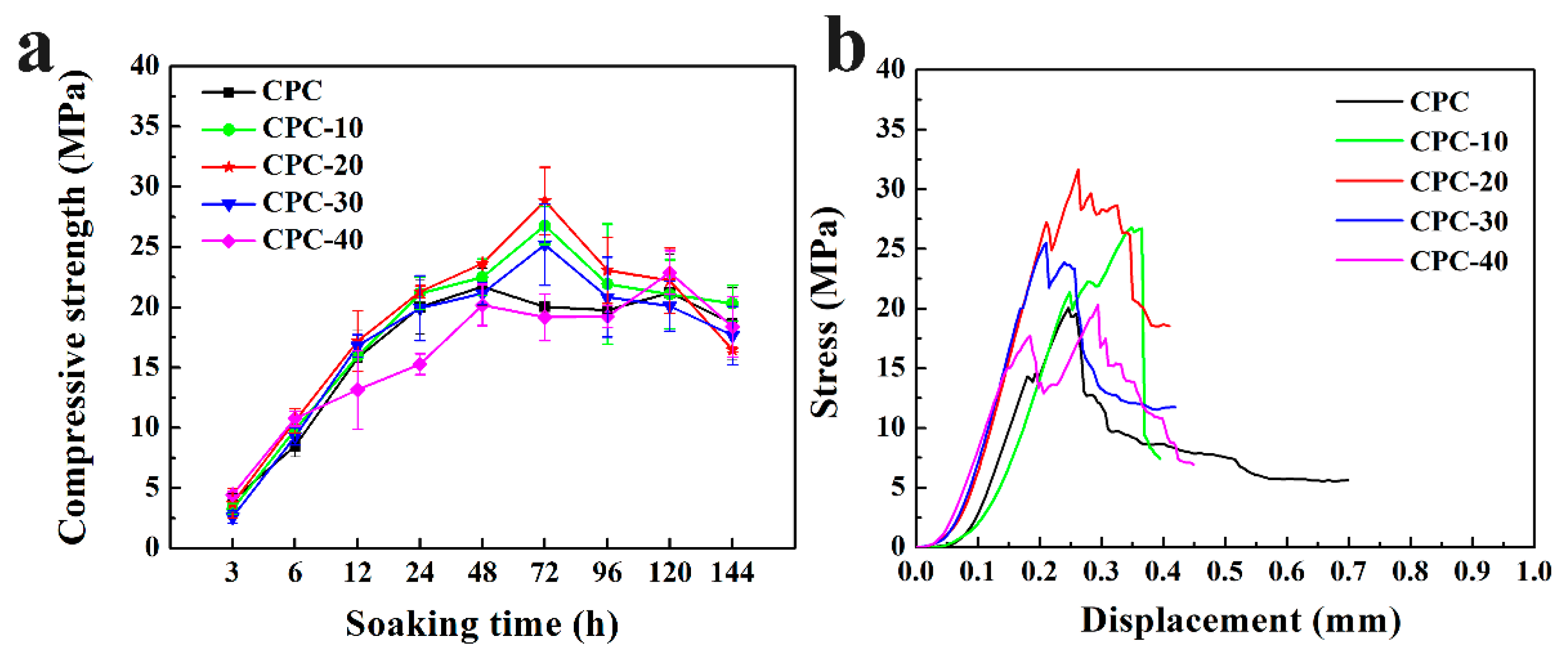

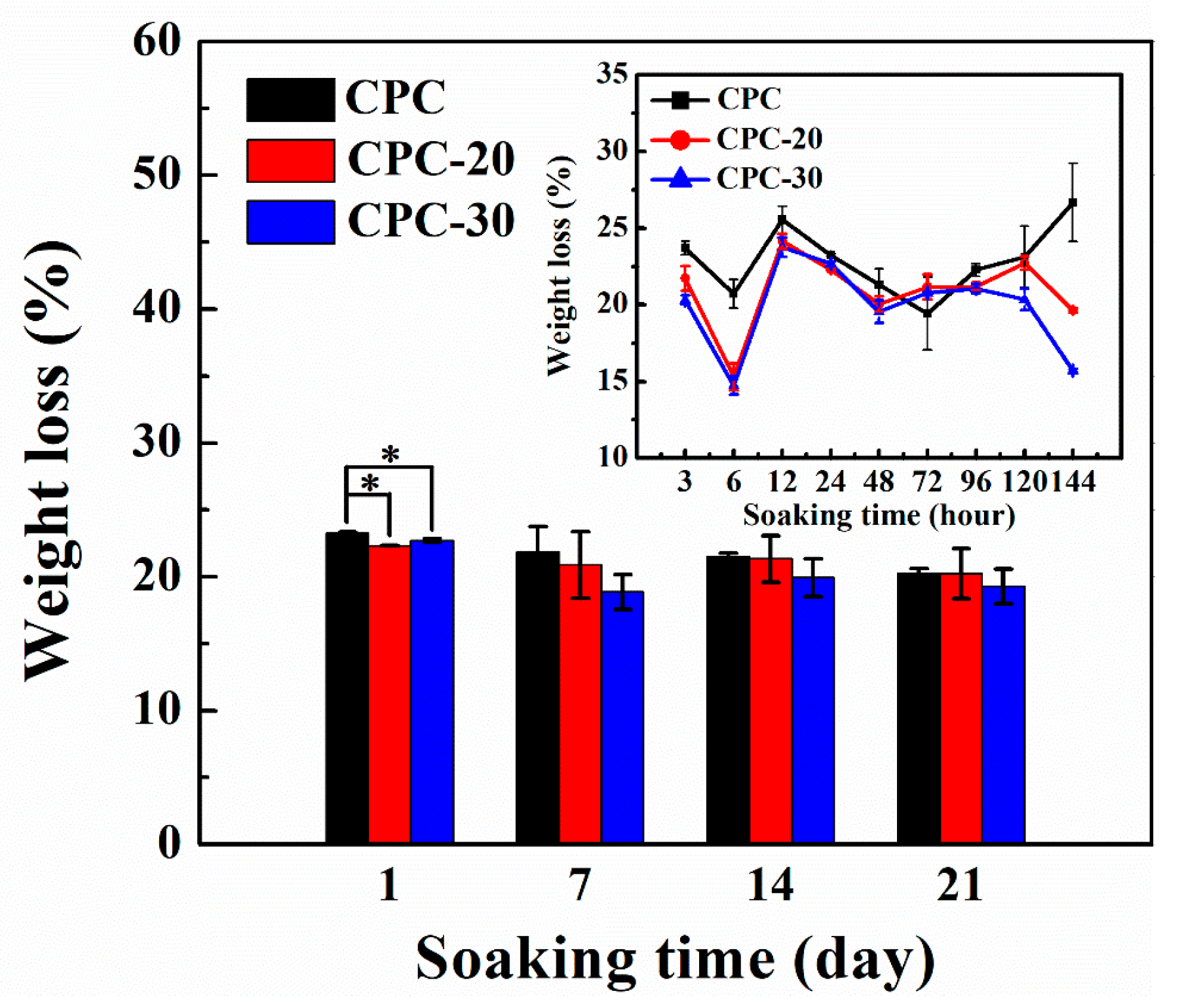
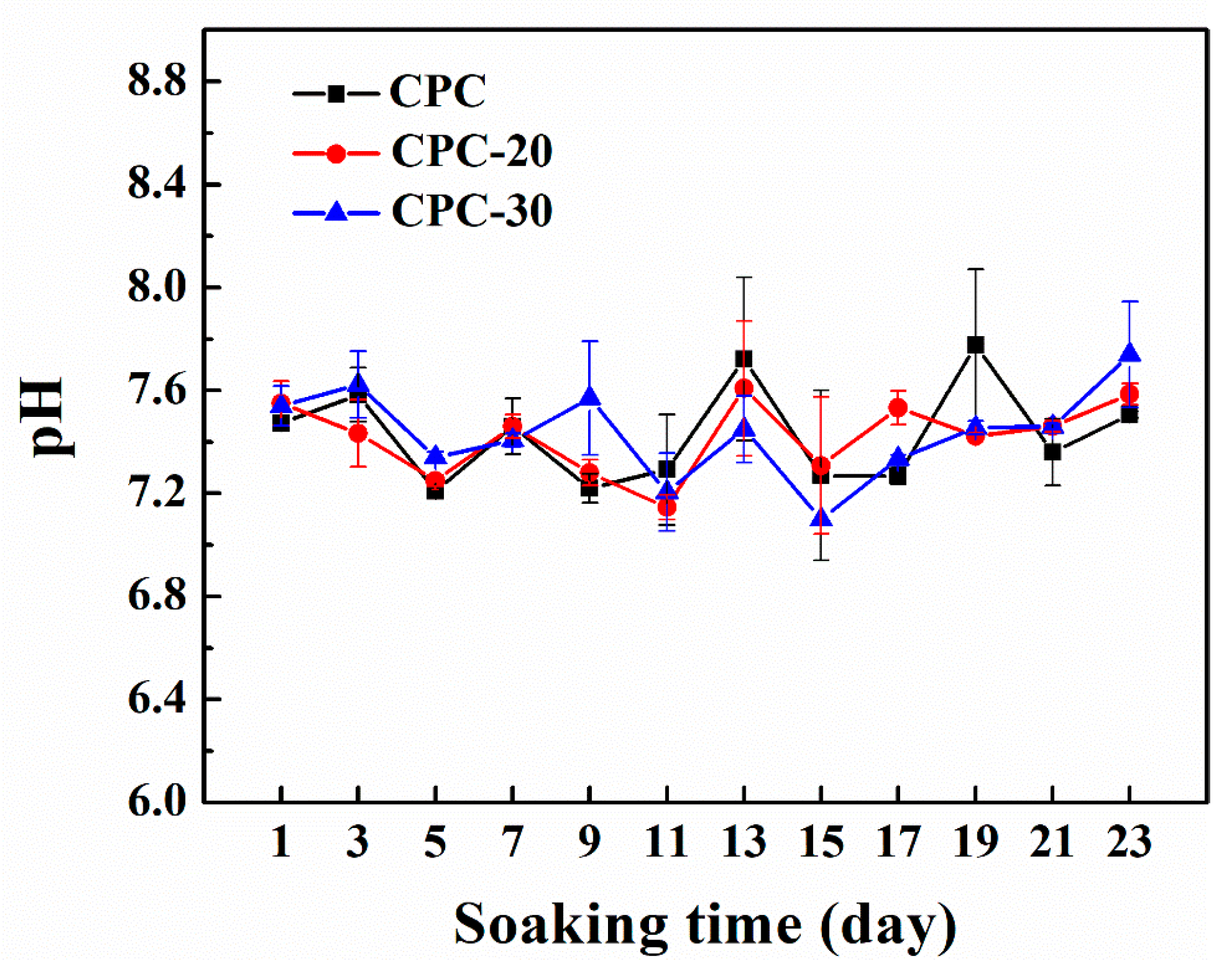
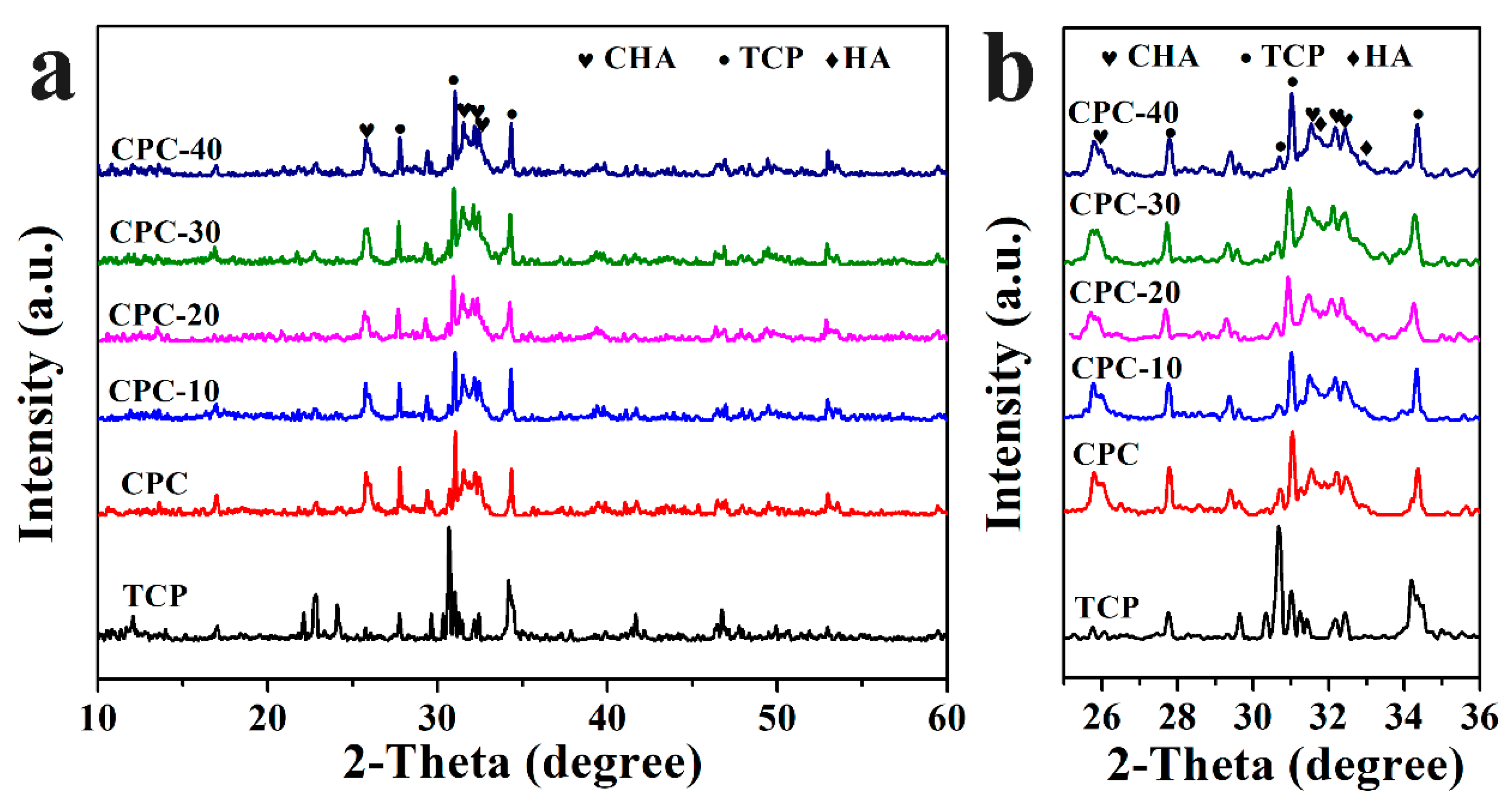

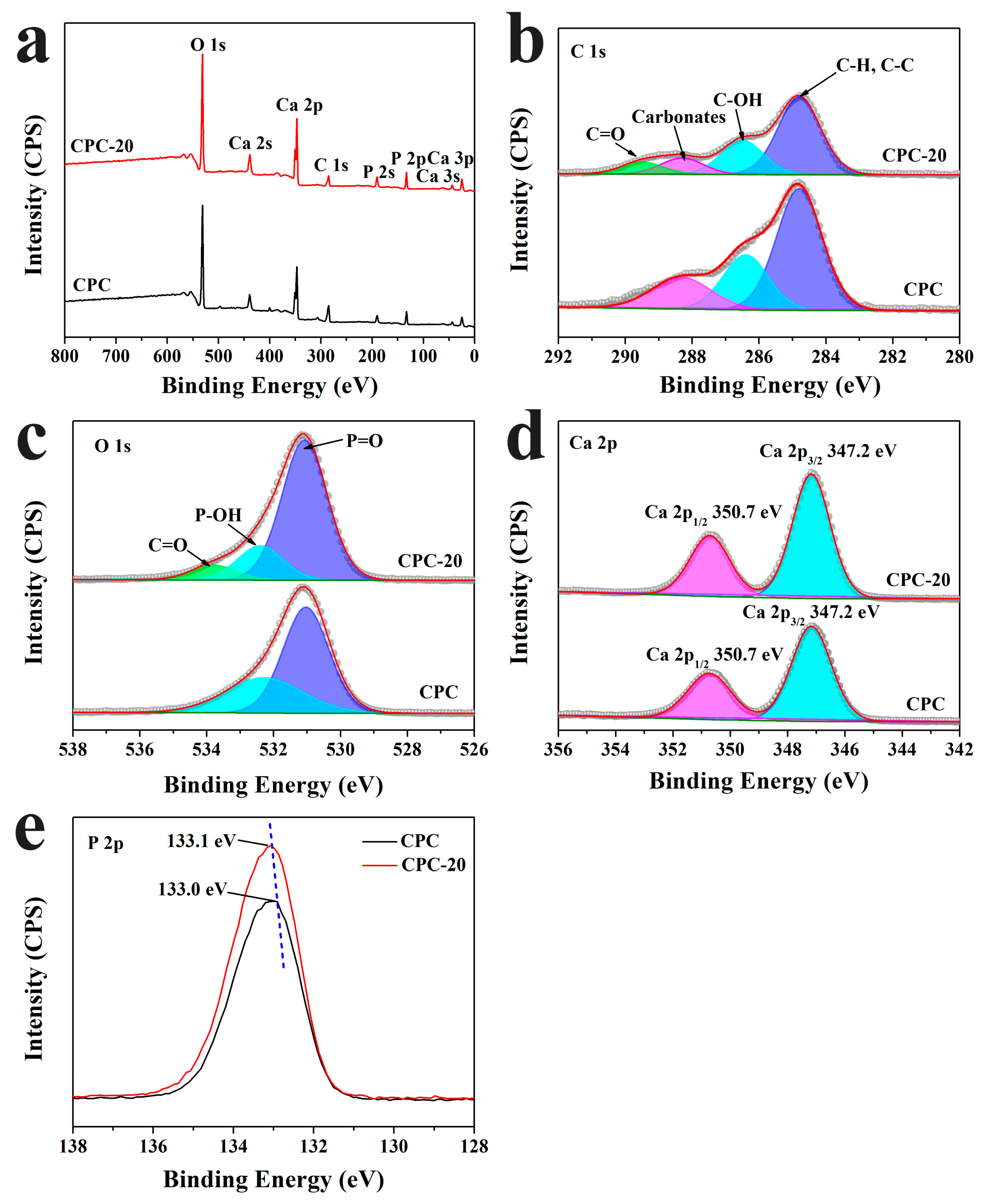

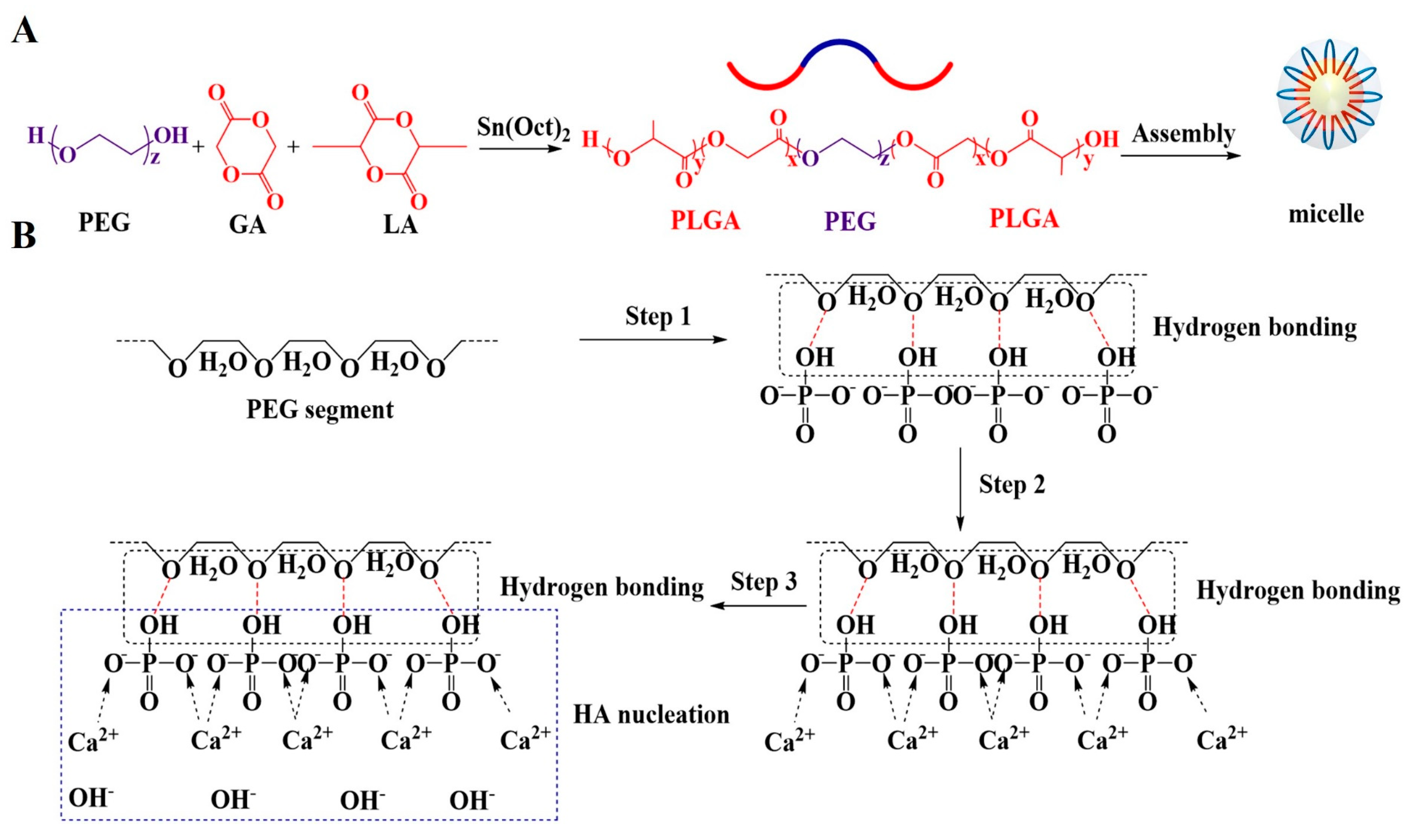
| Solid Phase | Liquid Phase | Setting Time (min) | Compressive Strength (MPa) | Injectability /Anti-Washout Property | Ref. |
|---|---|---|---|---|---|
| Partially crystallized calcium phosphate (PCCP), CaHPO4 (DCPA), HA, PAAS | Deionized water | Ti = 11 Tf = 30 | 23.4 | yes/well | [10] |
| CaHPO4, Tetracalcium phosphate (TTCP), gelatin microspheres | 6 wt% Na2HPO4 solution | Ti = 14 Tf = 25 | 6.5 | yes/not researched | [11] |
| PCCP, DCPA | KGM/GG solution | Ti = 10 Tf = 20 | 15 | yes/well | [12] |
| PCCP, DCPA | 1% LBG solution | Ti = 16 Tf = 40 | 15.9 | yes/well | [13] |
| Alpha tricalcium phosphate (α-TCP), CaCO3, HA | 2% Chondroitin Sulfate solution | Ti = 7 Tf = 53 | 22 | high/poor | [14] |
| Samples | Na2HPO4, % v/v | PLGA-PEG-PLGA Hydrogel, % v/v |
|---|---|---|
| CPC | 100 | 0 |
| CPC-10 | 90 | 10 |
| CPC-20 | 80 | 20 |
| CPC-30 | 70 | 30 |
| CPC-40 | 60 | 40 |
Publisher’s Note: MDPI stays neutral with regard to jurisdictional claims in published maps and institutional affiliations. |
© 2020 by the authors. Licensee MDPI, Basel, Switzerland. This article is an open access article distributed under the terms and conditions of the Creative Commons Attribution (CC BY) license (http://creativecommons.org/licenses/by/4.0/).
Share and Cite
Xie, Y.; Liu, J.; Cai, S.; Bao, X.; Li, Q.; Xu, G. Setting Characteristics and High Compressive Strength of an Anti-washout, Injectable Calcium Phosphate Cement Combined with Thermosensitive Hydrogel. Materials 2020, 13, 5779. https://doi.org/10.3390/ma13245779
Xie Y, Liu J, Cai S, Bao X, Li Q, Xu G. Setting Characteristics and High Compressive Strength of an Anti-washout, Injectable Calcium Phosphate Cement Combined with Thermosensitive Hydrogel. Materials. 2020; 13(24):5779. https://doi.org/10.3390/ma13245779
Chicago/Turabian StyleXie, Yao, Jia Liu, Shu Cai, Xiaogang Bao, Qianqian Li, and Guohua Xu. 2020. "Setting Characteristics and High Compressive Strength of an Anti-washout, Injectable Calcium Phosphate Cement Combined with Thermosensitive Hydrogel" Materials 13, no. 24: 5779. https://doi.org/10.3390/ma13245779
APA StyleXie, Y., Liu, J., Cai, S., Bao, X., Li, Q., & Xu, G. (2020). Setting Characteristics and High Compressive Strength of an Anti-washout, Injectable Calcium Phosphate Cement Combined with Thermosensitive Hydrogel. Materials, 13(24), 5779. https://doi.org/10.3390/ma13245779




